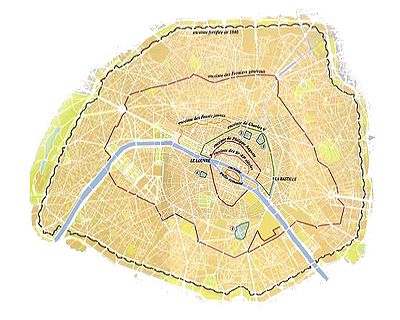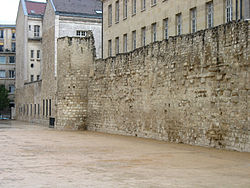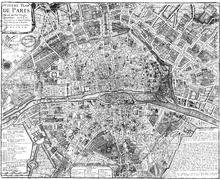- City walls of Paris
-
Over time, several city walls of Paris were built :
- a gauloise enclosure (unknown location)
- a Gallo-Roman wall
- two medieval walls including the main one : the wall of Philippe Auguste
- the wall of Charles V, extending on the right bank
- the Louis XIII wall, extending on the western part of the right bank
- the Wall of the Farmers-General, for tax purpose
- the Thiers wall.
From ancient times up to the twentieth century, Paris was always surrounded by walls, except for roughly a century between 1670 (date of the demolition of Louis XIII wall ordered by Louis XIV) and 1785 (date of the beginning of construction of the Farmers-General wall).
The purpose of these walls was to defend the town and protect people, but also, later, to assess taxes for goods sold in Paris (The Farmers-General Wall). Phillipe Auguste's wall marked the first time Paris had really been protected from attack in any substantial way, and allowed the town to both consolidate and expand, frequently to slightly more than could be contained by the existing walls.
As Paris grew, new houses were built inside the wall, but also outside the wall. After some decades, the wall was destroyed and the place of the wall rebuilt or transformed into a street or boulevard, with a new wall being built outside, including more houses and sometimes gardens or vegetable fields.
Only a few traces of these walls survive: a few sections of the wall of Philippe Auguste and some pavilions of Claude Nicolas Ledoux which were part of the Farmers General Wall. The main contribution to the layout of Paris made by the walls is the major streets and concentric boulevards:
- The 'Grands boulevards' (main streets), built by replacing the walls of Charles V and Louis XIII;
- The outer boulevards, built in place of the Wall of the Farmers-General;
- The 'boulevards des Maréchaux' (Boulevards of the Marshals, a loop encircling the city consisting of boulevards named for the Marshals of France), built to replace the Thiers wall; and
- The Boulevard périphérique (ring road or beltway), built outside the boulevards des Maréchaux.
The parallel streets, Rue de Cléry and Rue d'Aboukir in the second arrondissement, mark the placement of the wall built by Charles V.
Contents
Gauloise enclosure
In its Commentaries on the Gallic War, Julius Caesar wrote : "Id est oppidum Parisiorum, quod positum est in insula fluminis Sequanae", indicating that Lutetia (former name of Paris, the town of the tribe of Parisii) was a fortified camp on an island. The identification of this island with the Ile de la Cité is possible, but disputed, because it could be in fact Nanterre. The first wall of Paris was therefore probably built by the Gauls and coupled with the natural protection of the river Seine.
Gallo-roman wall
At the time of the roman empire, people and houses spread on the banks of the river, particularly the left one. During the first barbarian invasions, in 285, the people of Lutetia abandoned the left bank and took refuge on the Island of the City. The eastern half of the island was protected by a wall, construction for which rocks were collected from the Arènes de Lutèce.
First medieval wall
The existence of an enclosure around the centre of Paris, on the right bank, around the tenth century is probable. During recent research, the INRAP has discovered traces of this enclosure at the corner of rue de l'Arbre-Sec and rue de Rivoli.
Wall of Philippe Auguste
Main article: Wall of Philip II Augustus, ParisThe wall of Philippe Auguste was built from 1190 to 1213, enclosing 253 hectares on both sides of the river Seine. Many elements have been incorporated later into civil buildings or the Charles V wall.
Wall of Charles V
Main article: Wall of Charles V, ParisThe wall of Charles V was built from 1356 to 1383, during the reign of Charles V and his son and successor Charles VI. It was built only on the right bank (keeping the Philippe Auguste wall on the left bank), enclosing 439 hectares on both banks. It included the mansions of the Marais and the templar enclosure. It was partially destroyed during the construction of the walls of Louis XIII, and partly incorporated into it.
Louis XIII wall, sometimes called "the yellow ditches wall"
The Louis XIII wall was built from 1633 to 1636 designed by Jacques Lemercier. It enlarges the Charles V wall over the western part of the right bank (now 1st and 2nd arrondissements of Paris).
From 1670 onwards, Louis XIV believed that as a result of his conquests, Paris had been made a secure city. He ordered the wall destroyed and replaced it with the future grands boulevards.
Wall of the Farmers-General
Main article: Wall of the Farmers-GeneralThe Wall of the Farmers-General was built in a few years from 1785, under the direction of Claude Nicolas Ledoux and at the request of the Ferme Générale. It enclosed 3402 hectares, when the village of Austerlitz was incorporated into Paris in 1818.
Later, this wall was replaced by the second belt of boulevards : Charonne, Ménilmontant, Belleville, La Villette, La Chapelle, Clichy, Batignolles, Courcelles, avenue de Wagram and Iena, streets Benjamin Franklin and Alboni, boulevard de Grenelle , Garibaldi, Pasteur, Montparnasse, Edgar Quinet, Raspail, Saint-Jacques, Auguste Blanqui, Vincent Auriol, Bercy and Picpus. Unlike previous was, the goal of this wall was not to defend Paris but only to force the payment of taxes on goods entering the capital. It was destroyed when Paris was extended up to the Thiers walls in 1860.
Thiers wall
Main article: Thiers wallThe enclosure was constructed from 1841 to 1844 after a law enacted by Adolphe Thiers. It covered 7802 hectares, along the boulevards des Maréchaux of today and a glacis extending to the location of today's Boulevard Périphérique. It was demolished between 1919 and 1929.
Source
- This page is a translation of its French equivalent.
Bibliography
- Renaud Gagneux et Denis Prouvost, Sur les traces des enceintes de Paris, Parigramme, 2004.
- Jacques Hillairet, Dictionnaire historique des rues de Paris.
- Guy le Hallé, Histoire des fortifications de Paris et leur extension en Île-de-France, Éditions Horvath, 1995.
- Guy le Hallé, in « Paris aux cent villages », mensuel (mai 1975–janvier 1982) :
See also
External links
- (French) Paris walls (with a map)
- (French) Guy Le Hallé, The history of “fortifications” (Thiers wall) à Saint-Ouen
- (French) Malakoff Infos, idem in Malakoff
References
Categories:- Fortifications of Paris
- Geography of Paris
- Boulevards in Paris
- Paris-related lists
- Urban planning in France
- Military history of France
- City walls
Wikimedia Foundation. 2010.






